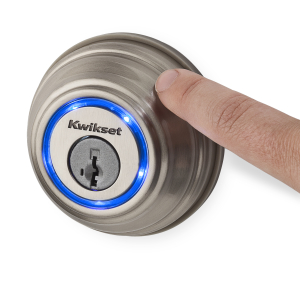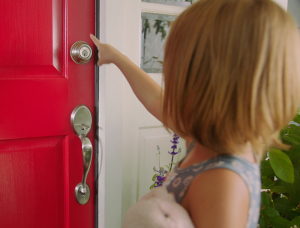Disclosure: Kwikset compensated Z. DesRocher, managing editor of the blog GeekDad and contributor to this article, with travel and tickets to the 2015 International CES.
As I made my way through CES 2015, I couldn’t help but get the feeling that I’d been lied to. Allow me to explain: the future I was promised was big and shiny and festooned with silver lamé jumpsuits. And also robots. Lots of robots.
Yet here we are, alive and well in the year 2015, and, well, it’s not exactly as advertised. Sure, CES had robots, both domestic-minded drones and interactive androids, but the average citizen does not. (Save for the occasional Roomba.)
The bottom line is this brave new world of ours isn’t about droids or jet packs or even self-tying shoes – and, yes, I know those are coming. Our grandest leaps in technology aren’t necessarily these big, intrusive showpieces; the latest and greatest in modern convenience isn’t a moon colony or a Rosie the robot maid, despite what generations of pop culture and wide-eyed futurism may have promised.
Modern innovation instead seems to have gone counter to what was predicted. It’s subtle. It’s integrated. It’s the Internet of Things.
I’ll admit, when I first heard that phrase some years back I really didn’t get it. I had visions of emails from my egg timer or tweets from my toaster, devices connected to the web for no other reason than that they could be.
Instead I now live in an automated house where I self-monitor home security via a tiny Piper hub that alerts me when a door is opened or when severe weather is on the horizon – even if I’m half a continent away. I have a Lyric thermostat that, rather than rely on a preconfigured schedule, monitors my position and goes into power-saving mode when the house is empty. My doors are outfitted with Kevo smart locks that lock and unlock at the touch of my hand.
These things are important to my peace of mind – not to mention a proper part of my daily routine – because they work within the existing infrastructure that is my automated smart home. They are seamless technology. They are integrated technology. They are fast becoming as much a part of my house as the doors and windows and outlets to which they connect.
 That last part’s a little sticky, though. You see, integration sometimes goes its own way. For example, Kwikset (they make the smart lock Kevo) has decided to partner with another smart thermostat provider, the popular Nest, for an even broader smart home offering – imagine a system that cuts home heating or cooling back to energy-saving levels as soon as you lock your front door. Meanwhile, Honeywell has expanded their Lyric thermostat into an entire line of smart security devices: sensors and control panels, designed from the ground up with compatibility in mind, that capitalize on both app functionality as well as voice control.
That last part’s a little sticky, though. You see, integration sometimes goes its own way. For example, Kwikset (they make the smart lock Kevo) has decided to partner with another smart thermostat provider, the popular Nest, for an even broader smart home offering – imagine a system that cuts home heating or cooling back to energy-saving levels as soon as you lock your front door. Meanwhile, Honeywell has expanded their Lyric thermostat into an entire line of smart security devices: sensors and control panels, designed from the ground up with compatibility in mind, that capitalize on both app functionality as well as voice control.
Then there are all those untapped resources, ZigBee controllers and Apple’s HomeKit, not to mention a myriad of other providers all seeking to smarten up everyday devices in new and interesting ways. The options, as they say, are limitless.
Which way will I ultimately go? Will I eventually shift to a single-provider system or continue my current piecemeal approach? Even I don’t know for sure.
Clearly no one can really predict tomorrow.
What I am sure of is that smart home tech has at least shown me the shape of the future. Maybe it’s not the one I expected, but it’s one I’m more than happy to explore.
Whatever providers or accessories or gadgets I adopt will rely on a number of factors: price, convenience, accessibility and the like. Most importantly, though, I won’t be looking for big obnoxious obvious technologies; I want simple elegance and clever integration. And also maybe that smart toaster.












It’s crazy how fast the Internet of Things is catching on. I didn’t think it would enter the home realm for a while but products like Kevo and Nest are great. Can’t wait to see how it evolves.